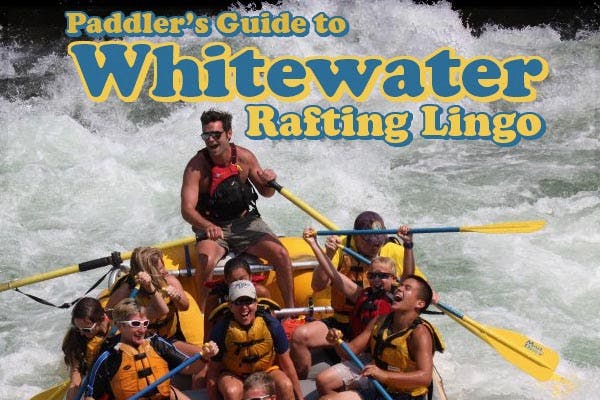Paddler’s Guide to Whitewater Rafting Lingo

There’s nothing quite like the thrill of a heart-pounding experience down the whitewater rapids of the legendary Snake River. When it comes to whitewater rafting, you’ll want to understand the language and lingo used, so you can react properly when given an instruction. Before you head off on your next adventure, brush up on a few specific whitewater rafting terms.
Bow
Easy enough, the bow is the front of the raft or boat you’re on. You’ll need to know this when being given directions.
Bump or Bumping
When you are on the water, your whitewater rafting guide may say (or yell) “Bump!” This generally will happen just before the watercraft hits a hard surface such as a rock. If you hear this, it’s best to lean into the center of the boat. Also, place the “T” of your paddle on the floor of the watercraft. Maintain your hand over the grip of the paddle when doing so.
CFS
Cubic feet per second or CFS describes volume. Specifically, you’ll hear this when describing the amount of water that’s moving past you at any given location. To give you a visual, one CFS is about the size of a soccer ball. If you are whitewater rafting on the Snake River, for example, this measurement is generally between 2,500 and 25,000 cubic feet per second. In other words, there are about 12,000 units of water moving past you every second.
Dig In!
Generally, this term is used when giving direction. You’ll hear your guide say “dig” or “hard forward, dig” while you are paddling. It is a description of a specific technique you’ll use. In it, you’ll want to push the paddle blade deep into the water. When doing so, you’ll reach the downstream current that’s deeper in the water. This is often necessary when you need to move your watercraft through larger holes.
Eddy out
Eddy out describes a hand gesture you’ll see used by guides when they need you to move to the side of the river. To notice it, you’ll see the guide place a hand in the air and motion it in a circle, and then point to the direction they want to move in.
The Line
The term line is used to describe the best path through a rapid or wave on the river.
Oars
Don’t make a common mistake and think an oar is a paddle. It’s a longer, stout pole that has a characteristic blade at the end. It’s also fastened to the boat.
Positive Pointing
On the river, your guide will “point positive,” which means they will point in the direction they want you to go. They may also be telling you where the proper line is when paddling.
A guide should never point at something and say, “Don’t go there…” That would be considered pointing negative, and is a river NO-NO.
Ready
We know you are excited now, but No, you are not technically ready. River guides will use this term to note that the watercraft is untied, you’ve coiled the lines, required training discussion is over, and all gear is in place. In other words, the boat is now fully readied by the guide, and can pull out of position at any time.
Wave Train
When rapids have three or more waves in consecutive fashion, this is a wave train. When this happens, the watercraft will move up and down rapidly, much like a thrill ride!
Come Join Us On the Snake River
How many of those terms did you know or think you knew but really did not? The goal of all Mad River guides is to keep you safe, while showing you a great time. Being able to communicate properly is one of the ways you can help accomplish both of those things.
So what are you waiting for? Book your whitewater adventure, and let our passionate Mad River guides show you a great time through the twists and turns of the Snake River.
